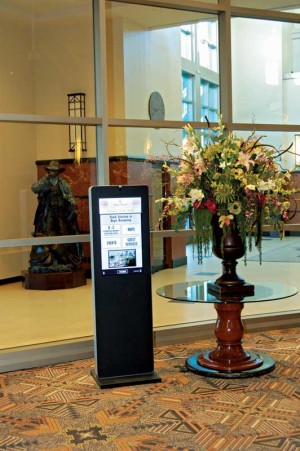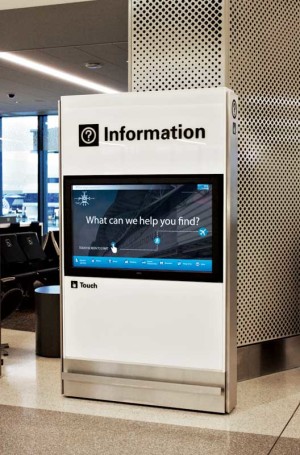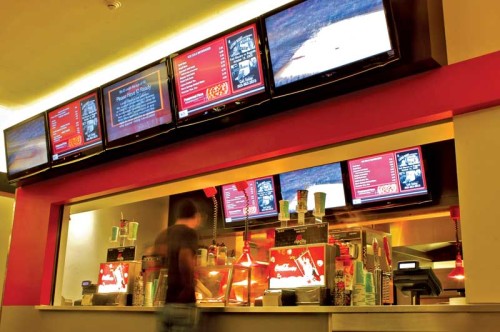Digital Signage: Breaking through the technology hype
by all | 29 March 2016 3:39 pm

Photos courtesy Omnivex
By Doug Bannister
Over the last few years, media analysts have been talking a lot about the ‘Internet of Things’ (IoT) and ‘big data.’ One may well wonder what these terms mean and how they will affect the way the sign industry does business. Certainly, they have come to represent an accelerated pace of development in information technology (IT) and an increase of options for businesses to deploy. Organizations can choose to stay their current course or adopt these new technologies to differentiate themselves from their competition.
With regard to the sign industry, the lightning-fast pace of change has been clearly seen in today’s visual communications. The medium of digital signage continues to grow as organizations find new applications for it. At the same time, many other technologies have reached the digital signage marketplace, including gesture control, near field communication (NFC), ultra-high-definition (UHD) ‘4K’ video and augmented reality (AR), all vying for attention.
For many of today’s organizations, the goal of engaging customers, employees and/or visitors with valuable information and rich-media experiences is no longer simply an idea tossed around at meetings, but rather an imperative to stay in business. Already, digital signage has helped some of them leapfrog ahead of their competitors.
That said, with so many new technologies promising to improve the viewer experience, it is important to break through the hype and consider how they can actually be used by organizations and what benefits they will deliver.
Interactivity
A lot of people immediately associate ‘interactivity’ with touch screens, but with the rise of IoT, the boundaries of the technology are being stretched much further. Today, interactivity can encompass the connections between sensors or other devices and the screen hardware viewed by individuals or groups.
By way of example, San Francisco International Airport (SFO) installed interactive wayfinding kiosks in its newest Terminal 3 boarding area in early 2014. In addition to being interactive in the traditional sense, i.e. by featuring touch screens that helped users navigate the facility, the kiosks were also integrated with a series of sensors and source systems. This integration allowed users’ wayfinding search results to reflect certain factors—like closed elevators or escalators—that would impact the route a traveller should take to get from point A to point B.
In another non-traditional application of interactive digital signage for wayfinding purposes, a manufacturing facility that used ammonia and had special systems in place to deal with potential leaks began to install screens to provide emergency evacuation notices. In this context, the on-screen content needed to depend on which way the wind was blowing. That is, if there were a leak, the wayfinding information needed to send employees not necessarily to the nearest exit, but to the nearest upwind exit in particular. As such, the digital signage was integrated with wind direction sensors.

Touch screens have been around for years and are well-accepted by the general population.
Touch screens
Touch screens are certainly a fundamental tool for interactivity today. They have been around for years and are well-accepted by the general population, thanks to the mainstream popularity of smartphones and tablet computers, like the Apple iPad. Most people—from small children to the elderly—know how to access information from a kiosk via touch.
Multi-touch interactivity is more useful than single-touch when (a) the screen needs to span large amounts of data quickly and/or (b) more than one person is addressing the screen at the same time. What much of the public does not realize, however, is each type of device supports its own multi-touch ‘language.’ Apple, for example, has patented the touch patterns for its ‘cut and copy’ and ‘search and replace’ functions. So, it has become problematic to choose the right system for a digital signage deployment.
For that matter, multi-touch has only specialized applications in the digital signage sector. It may provide a ‘wow’ factor the first time someone sees it in action with a large-format display, but its usefulness is very limited.
Gesture control
Interacting with content by hand gestures represents a powerful, cutting-edge user experience based on expressive communications, but while this technology has seen some popularity in the consumer electronics market with devices like Microsoft’s Kinect for Xbox game systems, it is not yet practical for digital signage deployments.
For one thing, despite Kinect, the concept is still in its infancy. As with multi-touch, there is no predefined way or universal language by which the public can interact with a screen by gestures.
For another thing, only specialized uses call for gesture interaction. Digital signs do not usually present Xbox-style games to the people walking past them. Most of the time, it makes more sense to simply use a touch screen instead.
A good example of where gesture-based control would be useful is in an operating room (OR), where doctors and nurses who have already scrubbed in could thus avoid having to touch a screen and risk getting contaminated.

Digital kiosks installed in San Francisco International Airport’s newest terminal not only feature touch screens, but are also integrated with a series of sensors and source systems that affect the wayfinding suggestions they offer.
Mobile
Mobile technology has certainly come a long way in recent years. Gone are the brick-sized cellphones of the past. Today, the vast majority of people in developed countries carry smartphones with them at all times.
As such, mobile devices are seen as an increasingly ideal way to connect the public to interactive, engaging digital signage content. The key is to integrate technologies like NFC or Apple’s iBeacon.
NFC itself is not new technology, but it is now seen as the next horizon for mobile devices because it allows them to serve as digital wallets. Indeed, many industry insiders believe NFC will be key to the advent of digital wallets because of (a) its ease of integration with existing systems, (b) its ease of adoption for consumers and (c) its usefulness in audience tracking and analytics. In these senses, it certainly has advantages over the once-ubiquitous Quick Response (QR) code.
Within the next few years, a large number of consumers are expected to own NFC-enabled smartphones, as the functionality continues to be added to handsets by major players in the mobile device manufacturing industry. As a result, in-store NFC-based payments will experience wider reach and adoption in the near future.
The real opportunity, however, could be with unattended point-of-sale (POS) systems, as found with vending machines, parking lots and transit stations and vehicles. Here, consumers will appreciate the convenience of paying by smartphone no matter their location. This two-way exchange of information, which can be integrated with related digital signage, will represent a new type of customer experience.
Apple’s recently launched iBeacon, on the other hand, is like a Global Positioning System (GPS) for indoor locations. If a mobile phone is so enabled, it can pick up related transmissions, such as apps or coupons, based on the user’s location.
While NFC is an established industry standard for contactless payments, it will be more difficult for Apple’s iBeacon technology to dominate the market. Not all smartphones are Apple iPhones, after all.
Screens
The types of screens suitable for digital signage applications continue to evolve, as do the applications for existing screens. There is no end to the options and possibilities, though there are certainly practical considerations that make some new concepts more useful and popular than others.
4K
Today, 4K UHD technology is in a transition phase. The current prices of 4K-capable screens are still quite high. In addition to the cost, it can be difficult to generate or source 4K content, let alone to store, render and transmit the much larger files.
Like any technology, of course, the prices of the displays will come down. Within the next few years, there will be a tipping point and 4K will become mainstream. Just as high-definition (HD) replaced standard-definition (SD), so too will UHD replace HD.
In the meantime, however, organizations are buying and installing screens at a higher resolution than their content. Even 4K sports broadcasts are displayed in HD for lack of sufficient bandwidth.

Many organizations install screens capable of higher resolutions than the content they actually present.
3-D
Three-dimensional (3-D) content is still lacking for consumer TVs, let alone digital signage. In an example of a perpetual Catch-22, content providers will not develop 3-D images if demand is too low and digital signage networks will not integrate 3-D screens without 3-D content.
Due to both impracticality and high prices, 3-D really does not stand a chance in the digital signage industry. The public is not going to wear special glasses and, for that matter, even the appeal of ‘glasses-free’ 3-D is starting to fade.
AR
To some degree, AR is being used to bridge the gap between large displays and mobile devices. The attempt is innovative, but AR is still a new technology looking for a home in the digital signage market.
Not only does the computer-generated imagery (CGI) need to appear super-realistic to have an authentic impression on its audience in public, but AR is also a niche application that requires a strong understanding of its interface. It is unlikely to enjoy wide adoption by the digital signage industry.
Measuring ROI
The best way to break through the technology hype and avoid simply throwing money away at new tools for digital signage is to measure the return on investment (ROI). Digital signage has seen a rapid increase in popularity because more organizations have recognized the true value it can add for them. It allows for live audience interaction, compared to previously static ads. It creates a prime opportunity for brand building. And it has been shown to influence consumer behaviour, from reducing perceived wait times to increasing POS sales revenue.
For digital signage to foster a stimulating environment, then, it must engage passersby and have an impact on their short- and/or long-term behaviours. Achieving these goals will depend on the nature of the organization.
ROI is important because of its broad applicability. At its simplest level, it is a matter of dollars earned versus dollars spent, a calculation of the gains from an investment less the cost of that initial investment. Each organization, however, has unique goals and therefore unique requirements for what can be expected in terms of ROI for any new technologies, products or processes.

Hospitals are using digital signage to improve operating room (OR) efficiency, but touch screens are likely to be shunned for the fear of the risk of contamination.
In fact, these objectives can even vary within an organization. Some digital signs might be used to help customers, for example, while others are intended to keep employees informed.
With this in mind, an ROI could indeed involve increased sales, but it could equally entail an increase in efficiency by yielding time savings for staff. It all depends on what the digital signage system will be used for.
Another way to calculate the effectiveness of digital signage, then, is return on objectives (ROO). ROI and ROO are closely intertwined. Digital signage used for wayfinding purposes, for example, may not appear to lead directly to an increase in revenues, but by freeing up time previously spent by employees providing directions to visitors in person, the system makes staff available to perform revenue-generating activities instead. Thus, a wayfinding system leads directly to an ROO and indirectly to an ROI.
It is also important to consider the time frame associated with a digital signage project. One way to judge ROI from a longer-term point of view is through the total cost of ownership (TCO). In the short term, for example, the initial cost of setting up a digital signage network may far outweigh that of printing static posters—but in the long term, with the ability to update on-screen content in real time, whether for a single digital sign in a certain location for a specific purpose or across an entire network simultaneously, the processes for digital signage become a
lot more efficient and the ROI starts to seem much more appealing.
Another, more subjective form of ROI is positive feedback. Indeed, it may be just as important to solicit responses from visitors before and after a digital signage installation, so as to determine the impact of the new technology and whether or not it meets the organization’s objectives. Even simply observing people can measure their response, e.g. how long they spend in front of a screen and then how many of them go on to buy a product advertised on that screen. More detailed ROI measurements can involve conducting surveys or interviews and recording their responses, to check if they not only noticed the digital signs, but actually found them helpful.

Digital signage has been incorporated into the architecture of the Air Canada Centre (ACC) in downtown Toronto.
If these methods are not sufficient, there are also ways to use more advanced technology to measure in greater detail. By integrating sensors, for example, it is possible to measure everything from foot traffic to interactive touch screen responses.
As the old saying goes, “You can’t manage what you don’t measure.” Fortunately, technology is making it ever-easier to measure the impact of digital signage in scientific terms. Businesses can track the medium’s performance over both the short and long terms.
It is particularly useful for companies to measure ROI for digital signage if they plan to start out small with a pilot project before rolling out a larger deployment over a longer period. Calculating ROI for the initial launch can provide a strong influence in finding better ways to manage the network later on.
Driven by digital signage
When considering all of the emerging tools in the visual communications market, then, it is important to remember digital signage should drive the choice of technologies, not the other way around. If an organization can first define what it is trying to achieve, then it can start down its path based on actual requirements, rather than hype. Any technology selected to support a well-thought-out business strategy should help reduce costs, increase revenue and endear digital signage to its viewers.
Doug Bannister is founder, CEO and chief technology officer (CTO) of Omnivex, a digital signage software developer based in Concord, Ont. For more information, visit www.omnivex.com[1].
- www.omnivex.com: http://www.omnivex.com
Source URL: https://www.signmedia.ca/digital-signage-breaking-through-the-technology-hype/